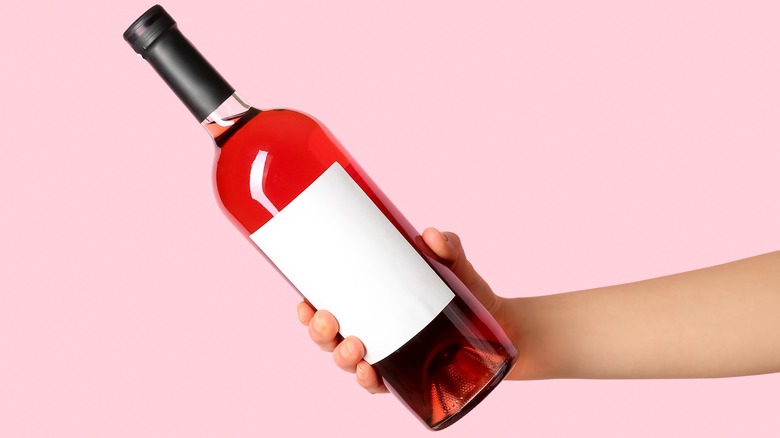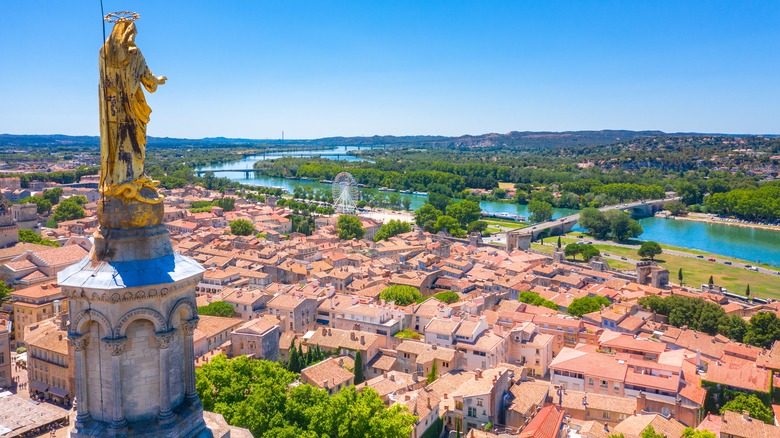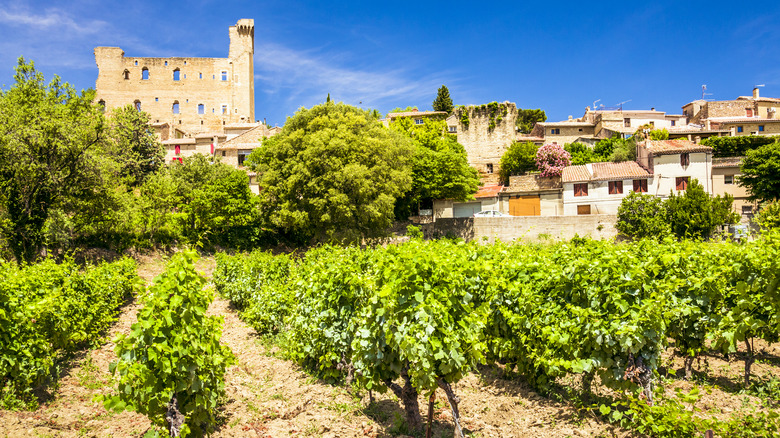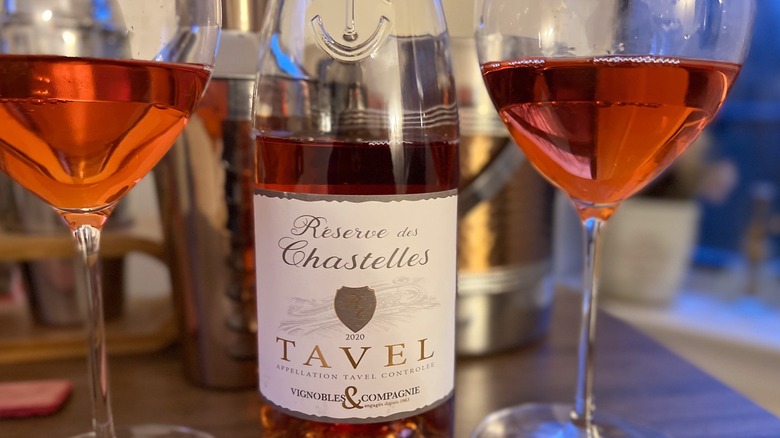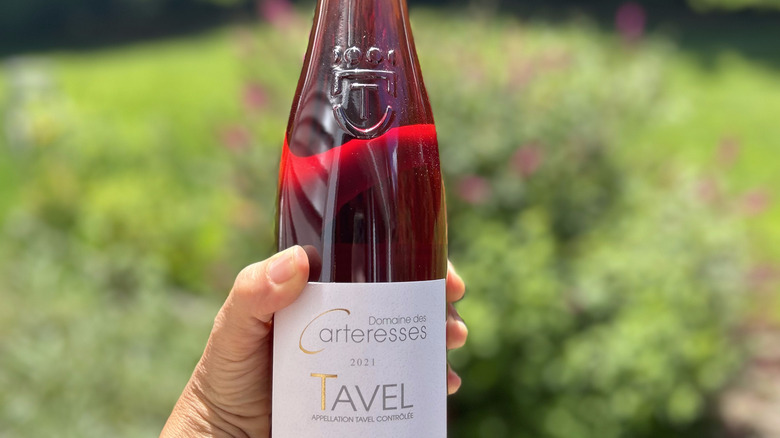Tavel Is The French Rosé That's Perfect For Hemingway Fans
Ernest Hemingway, a man of intense passions (and some quirky preferences), was in possession of a vast and discerning palate, for both food and drink. His favorite rosé was a wine from Southern France called Tavel. If it's hard to imagine Hemingway drinking rosé wine, you may need to try it yourself to understand. Affectionately referred to as the king of rosés, the rosé of kings, Tavel was a favorite among several kings and popes.
It's difficult to mistake a glass of Tavel for anything else. Its color — which Wine Folly classifies as deep pink on its charts — has been referred to as watermelon, salmon, deep ruby pink, or, simply, voluptuous. Too light to be called a red wine, and too bright to be considered a regular rosé, Tavel is sometimes called the fourth wine since it defies easy categorization. But Tavel's unusual qualities go beyond its unique color and merit further consideration, especially for wine drinkers who are looking for a rosé that brings something new to the table.
Tavel is the name of several things: a small town located in Southern France (but not in Provence!), a French appellation (AOC), and its wine. Most rosé wines are made from grapes that are also used for red wine-making; it is this process that differentiates pink wines from their older and more solidly structured red siblings. Tavel grapes, instead, are only used to make Tavel, which easily distinguishes it from other rosés.
History in the making of Tavel
The village of Tavel is in the Rhone area, bordering the renowned Chateauneuf-de-Pape wine region as well as the area of Avignon. It boasts a long history of wine grapes, brought first by the Greeks and then cultivated by the Romans. The name of the wine comes from references to a "villa tavellis," first mentioned in the 13th century.
By the 14th century, the greatness of the local wine was firmly established, and Tavel was a favorite of French King Philip IV, and later of both Louis XIV and Pope Innocent VI, whose residence was in nearby Avignon at the time. The pope loved his Tavel so much in fact, that he made sure he kept receiving stores of it even after the papacy returned to Rome (Prieuré de Montézargues was a special favorite). In order to protect the integrity of the wine, rules were established that nothing could be added to it and it was clearly labeled "C(ôte) d(e) R(hône)" so that it could not be adulterated with other wines as it journeyed across borders. That history was reflected when, in 1937, Tavel became the first official AOC rosé.
But the wine's popularity was not confined to one period: Tavel was cultivated and widely celebrated up through the first half of the 19th century, until the region's grapes were decimated by the devastating effects of Phylloxera vastatrix, which destroyed vineyards across Europe and hit the area around Tavel especially hard.
Grapes and terroirs of Tavel
While the grapes have made a comeback since then, rebuilding centuries of viticulture has been no small task. Fortunately, the richness of soil, skill, and culture has supported the slow but concerted efforts of local winemakers
Tavel's AOC comprises three separate terroirs: Olivet, Les Vestides, and Valongue, each of which endows the wine with varying fruit and mineral profiles, reflecting the presence of limestone, sand, clay, and distinctive rounded pebbles in the landscape; the wine's marked minerality gives it an edge that makes it more flexible in food pairing.
In wine-making terms, Tavel is truly a rosé. But it is born and bred differently from others of its kind: those three terroirs lend their flavor to Tavel alone, and the Tavel-making process includes longer contact with grape skins and fruit pulp, providing both a greater tannic structure than other rosés and the wine's unforgettable color. The tannins also mean that Tavels can actually age well – unlike most rosés, which should usually be drunk within a couple of years.
The grapes used to make Tavel are similar to those used to make other more familiar rosés: Grenache grapes form the backbone of most Tavels, and Syrah and Cinsault are often present as well. Both red and white grape varieties can be included, as long as the lighter types are macerated along with their darker counterparts. Mourvèdre, Clairette, Bourboulenc, Carignan, Picpoul, and Calitor grapes are all considered fair game — but no single grape can exceed 60% of the final product.
Taste of Tavel
Naturally, not all Tavels are alike. But they present a number of common features. They open with a surprising intensity, which is partly a result of their relatively high alcohol content (unlike Provence-style rosés, which generally shouldn't exceed 13% alcohol). Tavel wines generally demonstrate strong minerality, intense red fruits, full mouth-feel, and present tannins typical of light red wine.
While Tavels are dry across the board, the strong presence of red fruit makes them seem sweeter than other dry rosés, giving them a juicy fullness. Tavels demonstrate a variety of fruit notes, evoking flavors ranging from fresh strawberries and ripe watermelon to orange marmalade and berries. The fruit element balances out the tannins, giving the wine a robust quality. Tavels present a balanced acidity and a distinct spiciness that reflects their terroir and clearly differentiates them from other rosés.
Aged Tavels acquire deeper and more intense nuttiness and subtler floral notes. Herbal elements frequently make their presence felt as well; fragrances as diverse as mint and rose petals are sometimes referenced in wine tastings. Tavel wines complement a surprising variety of foods: they work with a variety of cheese and fish, roasted and saucy meats — including the stronger flavors of foods like ratatouille and tagine stews.
Getting your hands on an impressively affordable bottle
Vin-Tavel refers to Tavel as a "sun wine" for its depth, richness, and luminosity. And the price point is exceptionally friendly: if you can get your hands on a bottle, a good one can set you back a mere $20. But availability can pose a genuine challenge.
Provençal and Provençal-style rosés currently dominate the world market in pink wines, and Tavel cannot possibly compete — nor does it aspire to. Its production is limited both by local geography and culture: as the region has built back its grapes and wineries, the focus has been on bolstering the quality of its production rather than ramping up the quantity for exportation. Since there are only 902 hectares in the total area, the region can only produce so much. In a recent 5-year period, for example, Cotes de Provence generated 730,000 hectoliters of wine to Tavel's meager 45,000.
The massive popularity of other French rosés, with their paler color and flavor profile, has made Tavel a bit of an outlier, and more difficult to find. But, with the presence of online retailers, it is possible to find a nice Tavel or two — even if they're not available at your local supermarket or liquor store. And since Tavels are made of stronger stuff than most rosés, they're the perfect wine for making the transition from summer to fall, without breaking the bank. Yet another excellent reason to explore this delightful, historic rosé.
